cogsci200 lecture notes
03.05.24 (Computation I)
fundamentals: primitive objects and relations
all thinking processes = computation
Computational Theory of Mind: all mentation is computation, foundational claim about mind/brain computation in cog sci
“The mind is what the brain does: The brain processes information, and thinking is a kind of computation.” — Pinker
central assumption for cognitive science = brain is an information-processing system: cognition is computation
mind-body problem: mind is entirely distinct from body (thinking thing vs. extended thing)
computer is NOT a good metaphor for the mind
rather, mind and computer both compute and embody intelligence for the same reason
theory of aerodynamics and computation are both abstract and general
aerodynamics is applied to birds, planes, etc.
Computation
execution of algorithms that implement functions
physical processes transforming physical patterns of symbols
Alan Turing
What makes thought and intelligence possible? - Computation
Execution of Algorithms
algorithm = execution of a computational procedure
properties of algorithm
maps one set of symbols (input) into another set of symbols (output)
finitely specifiable (directions, duration, complete)
execution does not itself require “intelligence”
Symbols
physical states of bits of matter, chips in a computer or neurons in the brain (Johnson-Laird reading)
symbolize things in the world because they are triggered by those things via sense organs
symbols = patterns that denote or encode information
Functions
algorithms = step-by-step recipes that produce function
function maps each member of one set of symbols to a single member of another set of symbols
each input has unique output
palindrome is a function, reads same front to back and back to front
ex. mr owl ate my metal worm

plus 1 algorithm
steps are simple and mechanical
function can be defined over an infinite domain
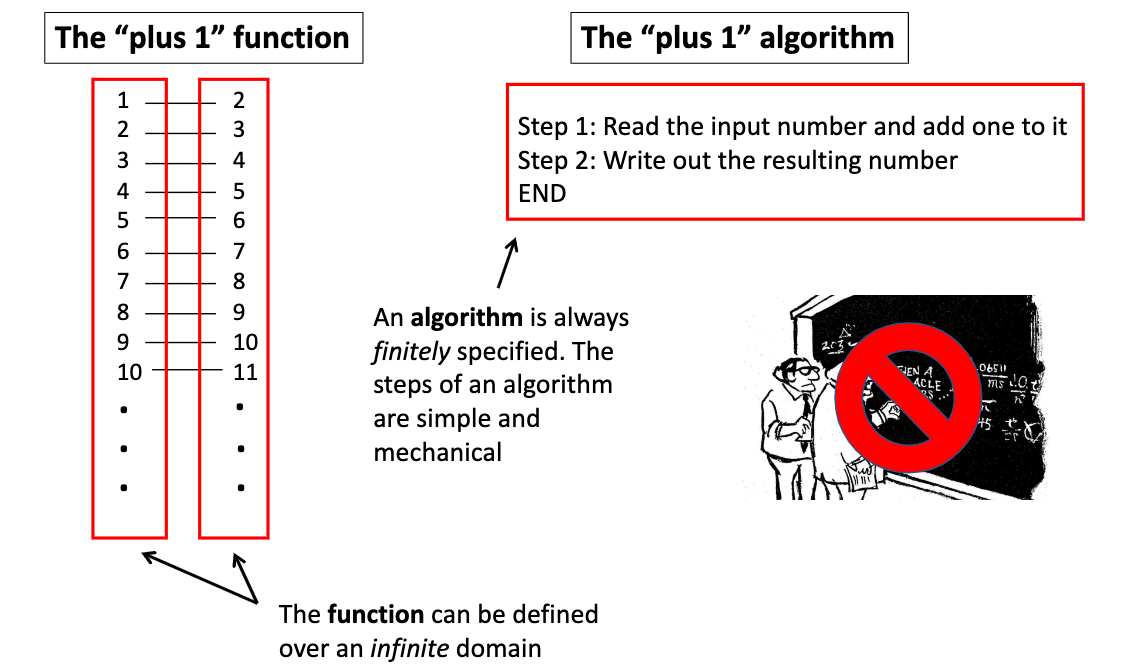
Quiz 10
Q1: B — Foundational claim in cognitive science → Thinking is a kind of computation
Q2: B — execution of algorithms itself requires intelligence (false)
Q3: D — According to the reading by Steven Pinker, the computational theory of mind (A & B: resolves mind-body problem, mental state = information manifested as symbols which are physical brain states)
Alan Turing
key part of WWll secret effort that led to breaking of Germany’s enigma machine coding scheme
primitive building blocks of computation
Turing Machine = idea/concept, not physical machine
contains minimal components that a physical machine needs for computation
Turing provided minimal formalization of computation
what can be constructed from primitives
Turing machines are maximally powerful → can compute any computable function
certain Turing machines are maximally flexible → can execute any algorithm
Turing Machine = computer
from 1600s-1940s, “computer” refers to people
women during the war when husbands were out on field
ex. woman thinking and reasoning to solve problems
goal: find minimal set of things needed for her to engage in computation
some components are necessary for her to compute: reading ability, her memory, etc.
other things are not: hair texture, clothing
stipulate that paper is endless
variety of symbols, binary code
state memory
state transition table contains step-by-step recipe for calculating function
input and how to map it to output
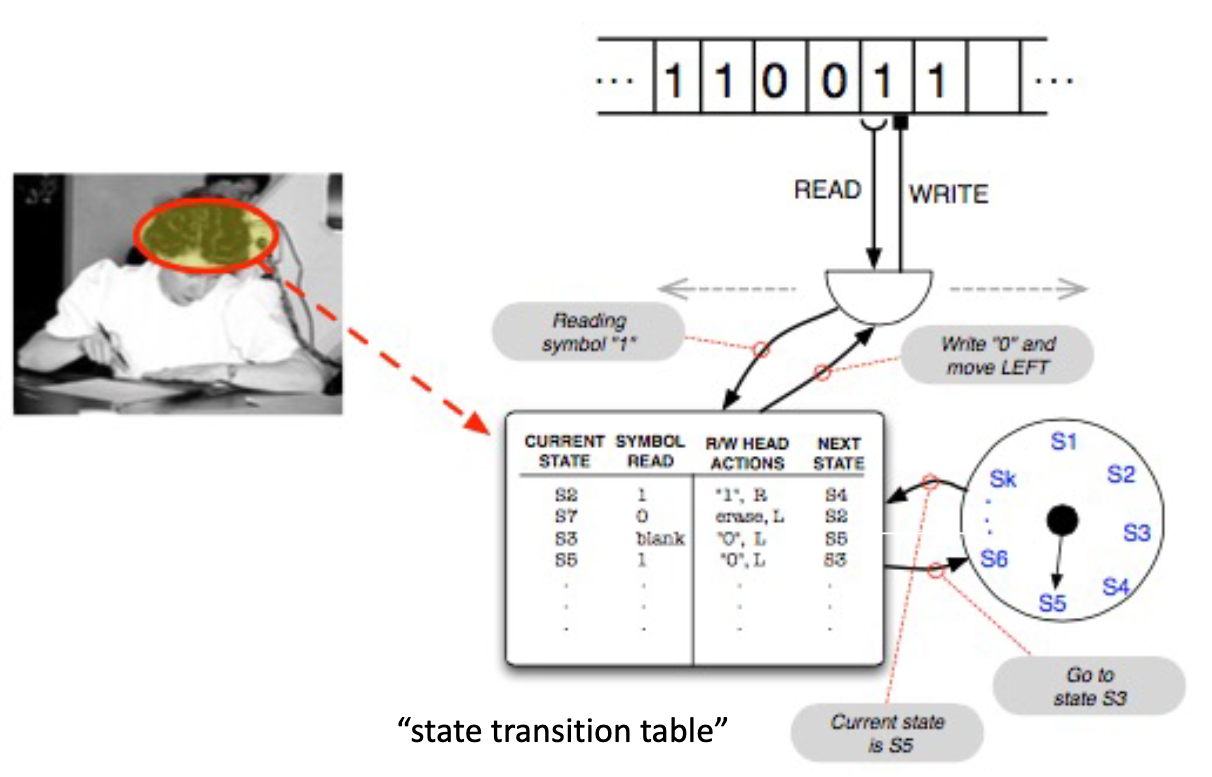 Turing machines and five primitives of computation
Turing machines and five primitives of computation
unlimited tape divided into cells that are either blank or have single symbol
list of symbols that is finite
read/write head positioned at a single cell on the tape and can read the symbol at that cell and write or erase a symbol
state memory = memory of internal states (finite)
finite transition table that determines the control of the Turing Machine with the following instructions:
if you are in one state and read a particular symbol, then write particular symbol on the tape, move R or L, and change state
needs input the machine reads, state the machine is in (find relevant rule), 2 input parts and 3 output parts
order the rules are listed in do not matter, depends on the input and state
03.07.24 (Computation ll)
Quiz 11
Q1: D — Turing machines (neither A or B)
Q2: A — Which component of a Turing Machine is infinite? Tape
Q3: B — Church-Turing thesis states that all conceivable functions can be computed by some Turing machine (false)
conceivable is not the same as computable
Marr’s levels of explanation and computation
functional: mapping of input to output
algorithmic: finitely specified computational procedure that generates specified mapping relation
physical: substrates in which algorithm is realized or implemented
same function can be computed by multiple distinct algorithms
single algorithm can be realized in multiple different physical substrates
Multiple realizability
single algorithm can be realized in multiple distinct physical substrates
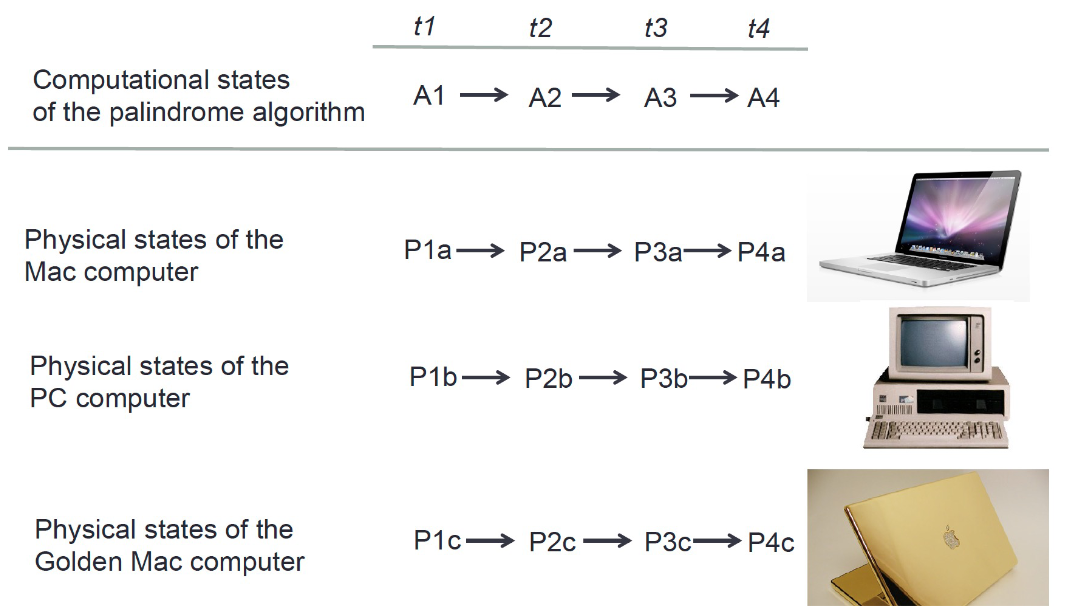
if all mentation is computation, then mental states and processes are also multiply realizable → a single mental state or process can be implemented in multiple different physical substrates
input-output equivalence
Turing claims
TM are maximally powerful — every element of the class of computable functions can be computed (Church-Turing Thesis)
There are Universal Computing Machines that are maximally flexible
Church-Turing thesis
A function is “computable” if and only if it can be computed by some Turing Machine
class of computable functions and the class of functions that can be computed by a Turing Machine are one and the same
function is “computable” if and only if there is some well-specified finite procedure for computing the function
thesis, not theorem; evidence makes it very plausible
Evidence for Church-Turing thesis
every formalism proposed as the basis of computation since 1936 has been shown to be mathematically equivalent to TM in computational power
large classes of functions have been proven computable by TM
increasingly complex computational functions continue to be implemented on physical computing machines
Is increasing TM power possible (increase set of possible computable functions)/disprove Church-Turing thesis
NO
allow it to jump to any cell on the tape
increase set of symbols
give it additional read/write heads
allow it to operate non-deterministically or probabilistically
Implications of C-T thesis
speculative argument
our mental capacities can be readily understood as functions
they are computable functions since our mind in fact does compute them
plausible claim: therefore, functions computed by these mental capacities can be computed by TM
conclusion: therefore, the five computational primitives are sufficient to explain the operation of these capacities
Limits on what we can construct
think of C-T thesis and Turing’s minimal formalization of computation as a big breakthrough (characterization of what can be computed in physical universe)
NOT every conceivable function can be computed/is computable
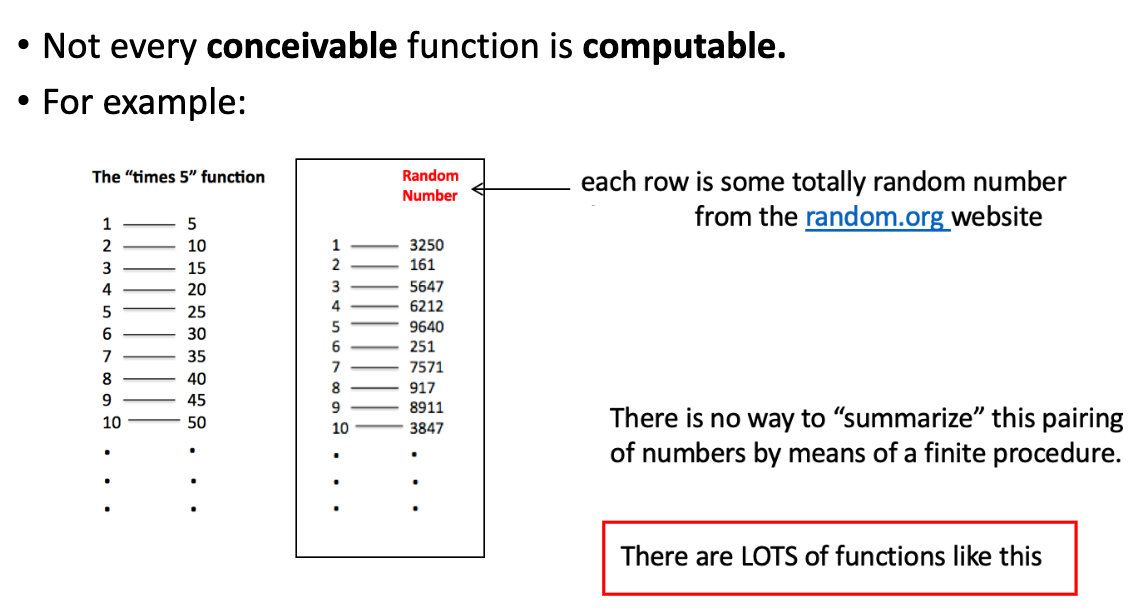 Halting Problem
Halting Problem
example of how conceivable does not equal computable
TM that will take input of description of another TM and some input for that machine, then halt with a 1 on the tape if the other TM will halt, and 0 otherwise → such a TM does not exist
speed and processing power not to be conflated with computing power
proof by contradiction; algorithm decides whether it stops or not (no algorithm can determine whether another computer program will halt or run indefinitely)
Class of computable functions: 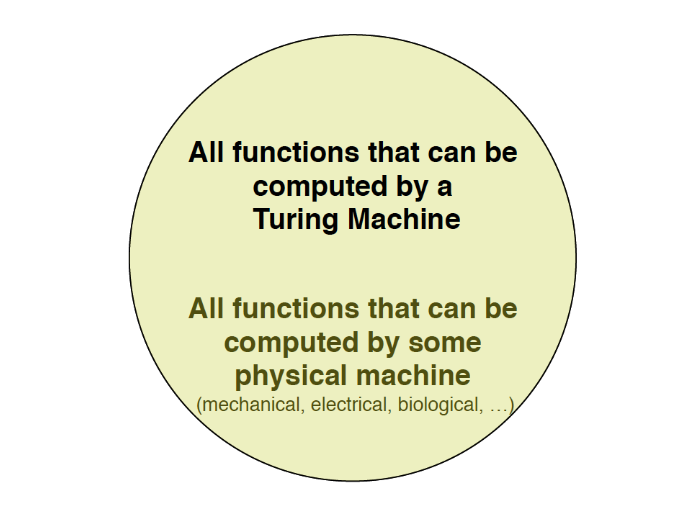 Class of all conceivable functions: (previous class takes up very tiny part)
Class of all conceivable functions: (previous class takes up very tiny part)
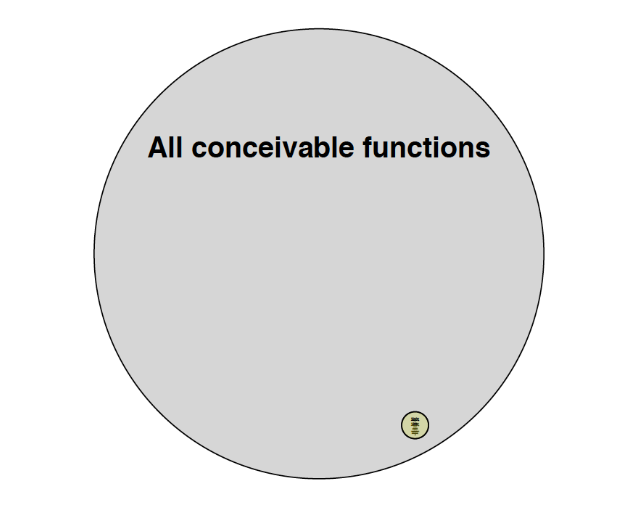 Interesting Problem
Interesting Problem
do not want to add new TM for every function that brains can compute
How do we explain how a single brain can do all the things that brains can do?
plausible that we have some modules for specific functions, but also plausible that the mind/brain is capable of more general, all-purpose computation
middle ground position: only some elements of the mind (especially perception) are modular
possible answer: universal computing machines
Universal Computing Machines
single TM that can compute every computable function
can simulate any other machine (taking as input a description of the function to compute and its input)
maximally flexible
does not change the relationship of all conceivable functions (same as previous venn diagram)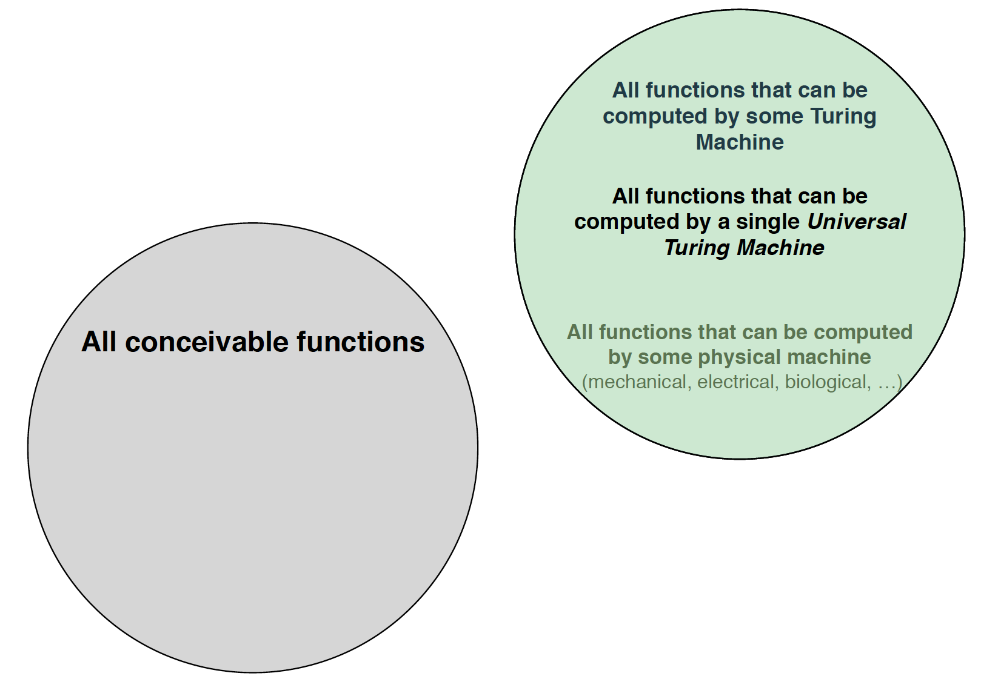
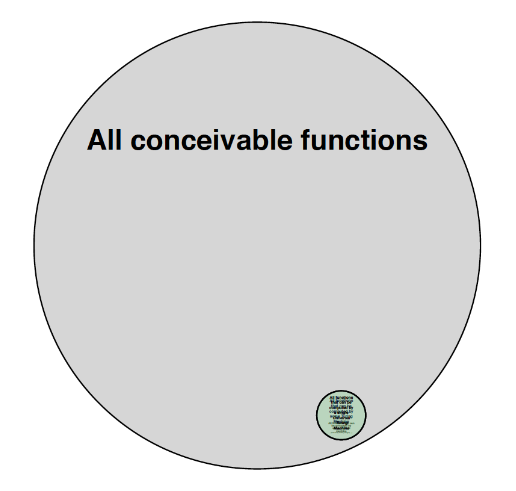 03.08.24 Discussion
03.08.24 Discussion
domain for